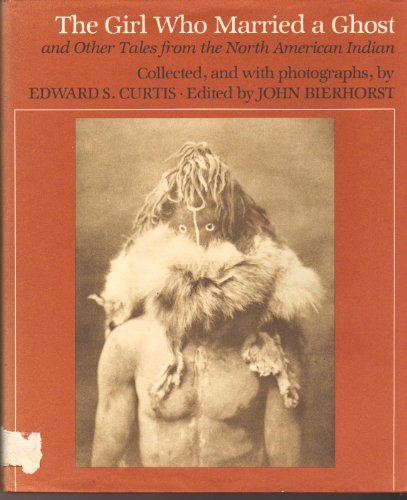edward curtis compiler john bierhorst (2 risultati)
Tipo di articolo
- Tutti gli articoli
- Libri (2)
- Riviste e Giornali
- Fumetti
- Spartiti
- Arte, Stampe e Poster
- Fotografie
- Mappe
-
Manoscritti e
Collezionismo cartaceo
Condizioni
- Tutte
- Nuovi
- Antichi o usati
Legatura
- Tutte
- Rilegato
- Brossura
Ulteriori caratteristiche
- Prima edizione
- Copia autografata
- Sovraccoperta (1)
- Con foto
- No print on demand
Paese del venditore
Valutazione venditore
-
The Girl Who Married a Ghost and Other Tales from the North American Indian
Editore: Four Winds Press, New York, 1980
Da: JBK Books, North Manchester, IN, U.S.A.
Libro
Hardcover. Condizione: Fine. Condizione sovraccoperta: Near Fine. 115pp; DJ unclipped. Contents clean and unmarked. No library stamps; no ownership name or markings. Third Printing.
-
The Girl Who Married a Ghost and Other Tales from the North American Indian
Editore: Four Winds Press, New York, NY, 1978
ISBN 10: 0590075055ISBN 13: 9780590075053
Da: Ground Zero Books, Ltd., Silver Spring, MD, U.S.A.
Libro
Hardcover. Curtis, Edward S. (Photographer) (illustratore). Reprint. Third printing, 1980. Sewn binding. Paper over boards. [14], 114, [2]. Illustrations. A note about the making of this book. Books by adn about Edward Curtis. From Wikipedia: "Edward Sheriff Curtis (February 16, 1868 October 19, 1952) was an ethnologist and photographer of the American West and of Native American peoples. Edward Curtis was born on a farm near Whitewater, Wisconsin. His father, the Reverend Asahel "Johnson" Curtis (1840 87), was a minister, farmer, and American Civil War veteran born in Ohio. His mother, Ellen Sheriff (1844 1912), was born in Pennsylvania. Weakened by his experiences in the Civil War, Johnson Curtis had difficulty in managing his farm, resulting in hardship and poverty for his family. Around 1874, the family moved from Wisconsin to Minnesota to join Johnson Curtis's father, Asahel Curtis, who ran a grocery store and was a postmaster in Le Sueur County. Curtis left school in the sixth grade and soon built his own camera. In 1885 at the age of 17, Edward became an apprentice photographer in St. Paul, Minnesota. In 1887 the family moved to Seattle, Washington, where Edward purchased a new camera and became a partner in an existing photographic studio with Rasmus Rothi. Edward paid $150 for his 50% share in the studio. After about six months, Curtis left Rothi and formed a new partnership with Thomas Guptill. The new studio was called Curtis and Guptill, Photographers and Photoengravers. In 1895, Curtis met and photographed Princess Angeline (c. 1800 96), aka Kickisomlo, the daughter of Chief Sealth of Seattle. This was to be his first portrait of a Native American. In 1898, three of Curtis' images were chosen for an exhibition sponsored by the National Photographic Society. Two were images of Princess Angeline, "The Mussel Gatherer", and "The Clam Digger". The other was of the Puget Sound, titled "Homeward". The latter was awarded the exhibition's grand prize and a gold medal. In that same year, while photographing Mt. Rainier, Curtis came upon a small group of scientists. One of them was George Bird Grinnell, an expert on Native Americans. Curtis was appointed Official Photographer to the Harriman Alaska Expedition of 1899, probably as a result of his friendship with George Bird Grinnell. Having very little formal education Curtis learned much during the lectures that were given aboard the ship each evening of the voyage. Grinnell became interested in Curtis' photography and invited him to join an expedition to photograph the Blackfeet Indians in Montana in the year 1900. In 1906, J. P. Morgan provided Curtis with $75, 000 to produce a series on the North American Indian. This work was to be in 20 volumes with 1, 500 photographs. Morgan's funds were to be disbursed over five years and were earmarked to support only fieldwork for the books not for writing, editing, or production of the volumes. Curtis himself would receive no salary for the project, which was to last more than 20 years. Under the terms of the arrangement, Morgan was to receive 25 sets and 500 original prints as his method of repayment. Once Curtis had secured funding for the project, he was able to hire several employees to help him. For writing as well as with recording Native American languages, Curtis hired a former journalist, William E. Myers. For general assistance with logistics and fieldwork, Curtis hired Bill Phillips, a graduate of the University of Washington. Perhaps the most important hire for the success of the project was Frederick Webb Hodge, an anthropologist employed by the Smithsonian who had also researched Native American peoples of the southwestern United States. Hodge was hired to edit the entire series. 222 complete sets were eventually published. Curtis' goal was not just to photograph, but to document, as much American Indian (Native American) traditional life as possible before that way of life disappeared. He wrote in the introduction to his first volume in 1907: "The information that is to be gathered.respecting the mode of.



